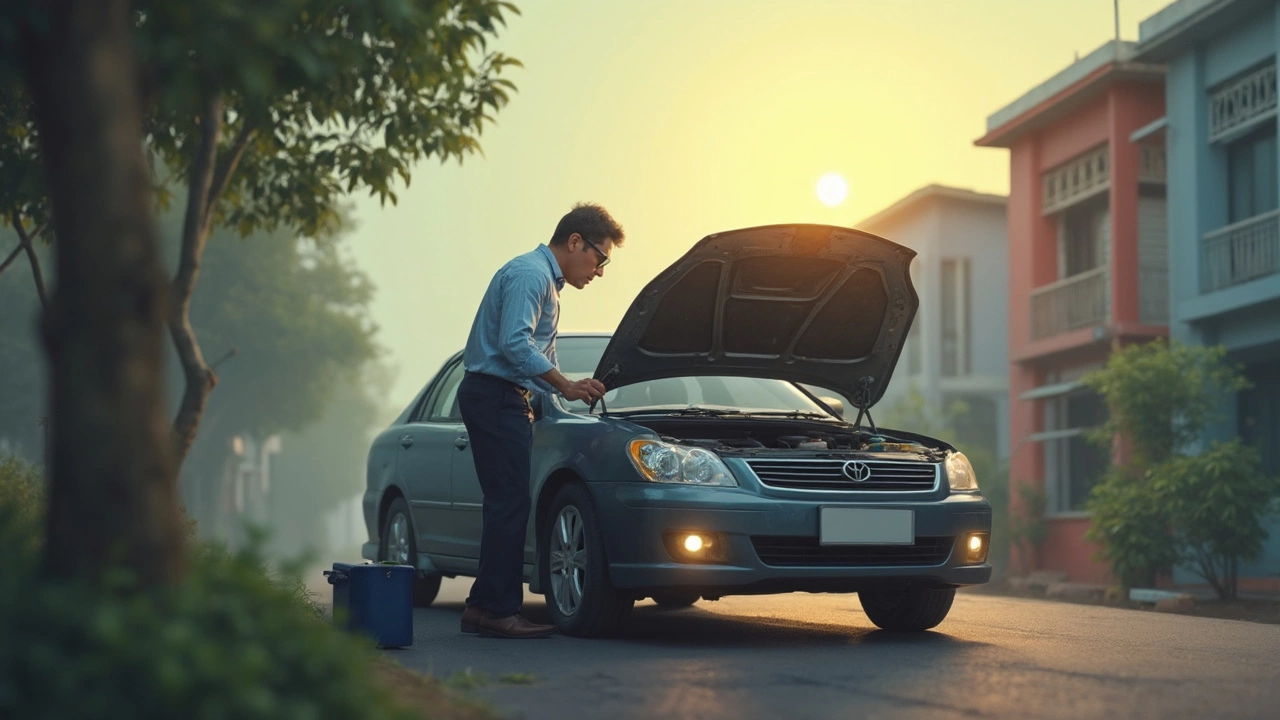How to Start Your Car with a Bad Fuel Pump: Quick Fixes & Emergency Tips
 Jun, 28 2025
Jun, 28 2025
Ever tried turning the key and your beloved car just cranks and coughs, but refuses to roar to life? It's the sort of frustration that can drive you nuts, especially if you’re late for work and the cat’s staring at you through the window like you’re the idiot of the house. If you suspect your fuel pump’s the culprit, you’re not alone – this little gadget fails more often than you might think. The fuel pump is the unsung hero under your car bonnet, but when it lets you down, things get interesting, fast. So, what can you do when your fuel pump is acting up? Can you actually start your car with a bad one? The short answer: sometimes. But you’ll need a few tricks up your sleeve, plenty of patience, and a willingness to get your hands dirty.
Why Fuel Pumps Fail and What Really Happens Under the Bonnet
The fuel pump’s job sounds simple: deliver petrol from the tank to the engine. But when it goes bad, problems start piling up. You might get an engine that sputters, hesitates, or just refuses to start. Years ago, my own Vauxhall Astra started playing up. I’d always blamed the cold Birmingham mornings, but it turned out the fuel pump was croaking. Most fuel pumps last between 100,000 to 150,000 miles, but lousy fuel, blocked filters, or just relentless wear can take them down earlier. In the UK, over 35,000 pump replacements are logged each year. They aren’t bulletproof, and when they go, they usually give a few warning signs first: whining noises, trouble starting, or sudden power loss while driving.
The strangest part? Cars with bad fuel pumps can sometimes be coaxed into life, at least for a short drive. That’s because, unless the pump is completely dead, it might work sporadically. When it’s only half-broken, you can still get the engine running with the right know-how. Of course, none of this is permanent, and if you’re using dodgey fuel or letting your car run near-empty too often, you’re playing with fire. The pump relies on fuel for cooling and lubrication — when you run the tank dry or fill up with rubbish petrol, you’re inviting problems. Fun fact: fuel pump failures spike after unusually hot UK summers because vapour lock becomes more likely, starving the pump of petrol.
There’s no magic fix, but knowing what’s actually going wrong under the bonnet gives you the best chance to squeeze another drive out of your car before booking in a proper repair. When the pump’s knackered, treating it gently (and quickly!) can help you get to the garage, but it’s not a miracle cure. Let’s get into some practical ways you can coax a failing pump into a last hurrah.
Emergency Fixes: Getting Your Car Started with a Bad Fuel Pump
So your car won’t start and you’re pretty sure the pump’s at fault. You don’t have to call for a tow just yet – there are a handful of things you can try. These might just get your car running for a short while, enough to roll into a mechanic’s bay, or pray you make it to your destination. Here are some tried-and-tested tricks I’ve picked up from weekends under the hood and worn-out car forums.
- Kick or Tap the Fuel Tank: Sounds daft, but it can work. If the pump’s stuck or weak, a sharp tap might unjam it for a few more spins. Use the sole of your shoe – just one firm kick on the tank’s underside (don’t use a hammer, you’ll dent it). This works only if the pump is still hanging on by a thread and it’s an old-style electric one, not a high-tech module.
- Turn the Key…Several Times: Try cycling the ignition. Without starting the car, turn the key from ‘off’ to ‘on’ three or four times, pausing for a couple of seconds each time. This primes the fuel line by giving the pump repeated shots at running before the starter kicks in. You might hear a faint whirr if it’s got any life left.
- Add Fuel (Even If You're Not Empty): Bad pumps sometimes get a second wind with a full tank. The extra pressure can help push fuel past a weak pump. Oddly enough, more than a few car owners have made it back home this way. Never hurts to try.
- Straight to the Relay: If your car’s ancient (think early 2000s), you can try bypassing the fuel pump relay with a wire to see if the pump will run directly, but truthfully, this is risky if you’re not confident with electrics. Don’t fry something you can’t afford to fix!
- Cool Down the Pump: In summer, fuel pumps overheat faster. Pouring a bit of water (not too much!) over the tank can sometimes cool it enough for one last run. My old neighbour pulled this trick during the 2022 heatwave when every breakdown was blamed on the weather.
Of course, these are stop-gaps, not real fixes. If you get your car started, drive straight to a garage. Don’t go running errands, don’t visit your mate, don’t push your luck. And never, ever try to drive long-distance with a failing pump unless you fancy a roadside breakdown on the M6.
For quick reference, here’s a look at how effective some common "hacks" are at saving a dying fuel pump (based on roadside assistance data):
| Method | Success Rate (%) | Notes |
|---|---|---|
| Tank Tap/Kick | 39 | Works mostly on older cars |
| Ignition Cycling | 48 | Depends on how broken pump is |
| Top Up Fuel | 27 | Helps with weak pressure, not dead pump |
| Cool Down with Water | 11 | Rarely, when overheating is issue |
| Relay Bypass (DIY) | 16 | Risky if not handy with wires |

Recognising Permanent vs Temporary Pump Failure: Don’t Get Stranded Twice
Here’s where people get it wrong – not every dead pump is truly dead. Sometimes the pump is just "tired" and sometimes it’s gone for good. Knowing the difference can help you decide if your car’s safe to limp home one last time, or if you should skip the risk entirely. For example, if you hear the pump whir (a soft buzzing for two seconds) when turning the key, there’s hope. If you hear nothing, odds are you’re stuck.
Modern cars are particularly fussed about even slight dips in fuel pressure. You might see the check engine light, but more often you’ll notice hard starting, spitting, or the engine giving up just after starting. If your car starts, runs a few seconds and dies, that’s usually the pump choking off. I’d always say: if you actually get going, don’t idle – keep your foot light and get straight to the repair shop. The number of people who stall just outside their driveway after one of these quick starts: not small! Avoid hills and heavy traffic, so you don’t end up blocking the high street and causing a scene.
Sometimes, the pump’s failure isn’t electric, but mechanical – gunked-up filters, bad wiring, or a dodgy relay. If you’ve got a multimeter and want to play detective, check for voltage at the pump fuse or relay. If no juice gets to the pump, a cheap relay may be your only problem, which is far less costly than a new pump. In over 20% of so-called "dead pump" cases attended by UK breakdown services, the real villain is the relay, not the pump.
If you can, keep a can of starter fluid in your boot. Safe use only: a small squirt into the air intake (after removing the hose) can help diagnose a fuel starvation issue. If the car fires up for a moment, chances are the pump’s to blame. Just don’t overdo it – engines and flames are not great mates.
And hey, if you smell strong petrol or see leaks under the car, don’t try to start it at all. You don’t want to turn a mechanical problem into a fire hazard. Safety first, even if your day’s already off-track.
What To Do Next: Preventing Future Fuel Pump Trouble
Alright, let’s say you managed to get your car running. Now’s the time to think longer-term. Fuel pumps rarely die out of nowhere. Once you’ve got a diagnosis, don’t delay the repair – all those emergency tricks are only temporary. One in three drivers who put off getting a dodgy pump sorted end up stranded within 72 hours. Prevention really is better than cure here.
- Don’t Run on Empty: Most electric pumps are cooled by petrol itself. Running on less than a quarter-tank means the pump is exposed and gets hotter. Fill up at a quarter-tank, not when the light’s blinking.
- Change Your Fuel Filter: A blocked filter forces the pump to work twice as hard. Most manuals say swap it every 24,000 miles, but many folks ignore this. It’s cheap and can add years to your pump’s life.
- Watch Your Fuel Quality: Cheap petrol with lots of ethanol can gum up pumps faster than premium. If your car isn’t designed for it, stick to what the manual recommends. Bad batches are often behind sudden pump failures after a fill-up.
- Listen for Noises: Pumps on the way out often make whining or humming sounds, especially just after turning on the ignition. Unusual noises are your warning sign – don’t ignore them.
- Get Regular Checks: Next time you’re at the garage for something else, ask them to test your pump pressure or check the relay. Takes five minutes, can save you a lot of heartache – and money.
Almost every motorist I know has a bad fuel pump story. My mate Dave got caught between New Street Station and the Bullring, crowd gawking at him, bonnet up, steam rising. If you take care of yours and treat emergency starts as just that – emergencies – you’ll save yourself a world of bother. And, trust me, Whiskers won’t judge you nearly as much when you finally get home, keys jingling in triumph.
No car is immune from fuel pump trouble, but with these tricks stashed away for emergencies, you won’t be caught twiddling your thumbs at the worst moment. Next time you hear a whine from under the floorboards, you’ll know exactly what to do – and how to avoid making things worse.